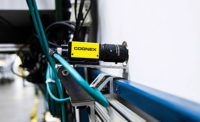“A 2D mockup can be something as simple as using chalk or tape on a concrete floor,” says Jamie Flinchbaugh, a partner at the Lean Learning Center and a former ASSEMBLY columnist. “Pieces of cardboard or styrofoam are typically used for a 3D mockup.
“This simple technique allows you to see things that you can’t see on a computer screen or on paper,” adds Flinchbaugh. “The physical nature of it is beneficial. If you can put your hand on something, it better engages all the senses.
“I always like to start with paper, because it’s faster than using a computer,” Flinchbaugh points out. “I recommend using a paper doll process. First, take scale picture of various workstations and pieces of equipment. Then, cut them up and move them around on a sheet of paper.”
“Digital tools and computer simulation are effective when the technology is applied appropriately,” says Matt Zayko, an associate at the Lean Transformations Group. “In the beginning, it is usually best to use a simple tool, since data and inputs are wide-ranging. As learning and information improves, then higher-level tools may be more useful for modeling ergonomic risks or cycle time issues.”
Ideally, process times are constant and balanced to each other. But, sometimes, this is not the case. “Simulation software can be helpful to better understand how variability in the process times will impact flow through the system,” explains Drew Locher, managing director of Change Management Associates. “Then, methods can be put in place to ‘buffer’ this variation, typically by allowing some standard work in process beyond one-piece flow at particular points in the process. If the variability is negligible, then simulation tools become less useful.”
According to Locher, 3D physical mockups are important tools for lean layout. “The more that can be done to make what is proposed tangible, the better,” he points out. “Problems can be more quickly identified and avoided. Better concepts for layouts will be the result.”
“A 3D mockup is a very simple, yet powerful tool for bringing ideas and concepts as close to reality as possible,” adds Zayko. “It can be done with cardboard boxes or tabletops. But, this tool should be done very early on for new products in the development cycle, since it supports fast learning cycles.” A 2D mockup is important, as well, and can also be used very early-on in the layout process.
“Physical mockups at or near actual size made with cardboard or structural aluminum tubing are a great, low cost way to test flow and [workstation] arrangement before committing capital,” says Kurt Greissinger, industry manager for assembly and handling at Bosch Rexroth Corp. “It can also be set-up in a common area to allow others to test and provide input without affecting the current production line.”
A lean concept gaining greater attention these days is 3P (Production Preparation Process). “It is a methodology that can be used to help facilitate a new product or process design,” says Locher. “One characteristic of this methodology is to use 3D mockups so that the people involved can touch and better feel what is being proposed. It is more experiential than simply looking at a drawing of a proposed layout on a table.”
Locher says physical mockups don’t have to be “pretty” to be effective. Simple materials should always be used.
“This practice was quite common many years ago,” Locher points out. “However, with the availability of computer-based drawing systems, people have moved away from it. I believe that this has occurred at the expense of developing better designs sooner, with fewer changes after implementation.”
“My sensei at Toyota once gave me a hard time when I used a computer to generate a proposal for a new layout,” recalls Sammy Obara, president of Honsha Associates. Obara spent three years studying lean manufacturing principles in Toyota City, Japan, and another 10 years applying it at Toyota assembly plants in Brazil, Venezuela and the United States
“That was the only time I made that mistake,” adds Obara. “[My sensei] then made me cut little squares and shapes on scale representing each machine and piece of equipment, and paste them on grid paper. Then, he made me draw lines by hand representing the route of each operator.
“I had to repeat that for different scenarios,” says Obara. “By the fifth or sixth time, I understood how much easier it was for the team to collaborate when things are done in this simplistic way. It was also easier for all to see the different configurations all at once, without having to scroll down or open a program.”
Another time, Obara was assigned the task of converting a brownfield factory in Venezuela into a Toyota plant under TPS regimen. “My first week was almost entirely dedicated to putting tape on the floor simulating the operators’ movement and then testing it,” he points out. “We even wrote down on the tape their cycle time and what exact time they would be at each process.
“In addition to that, there was a thick book on standards we had to follow,” adds Obara. “It had all the best dimensions of an aisle, space between machines, height of workstations, pathways for material handling, and most everything we could possibly need to put together a cell.”






